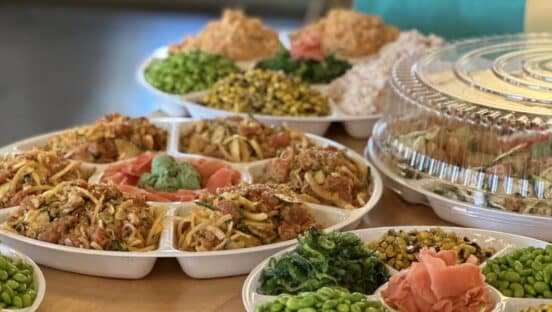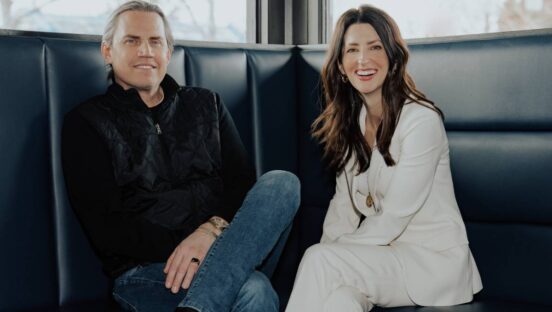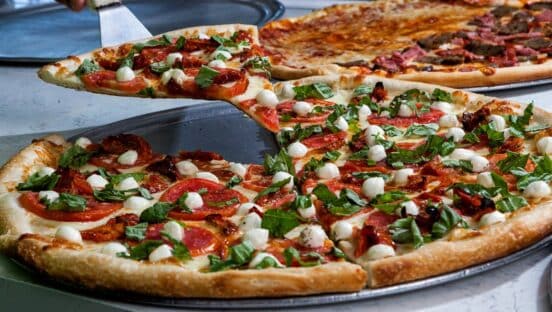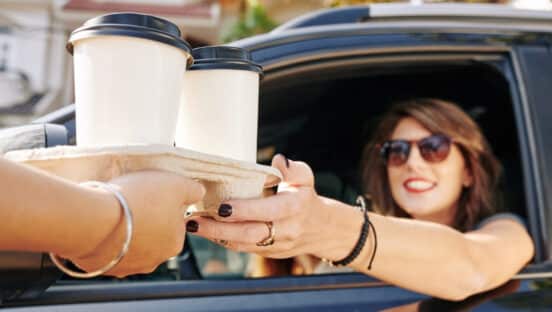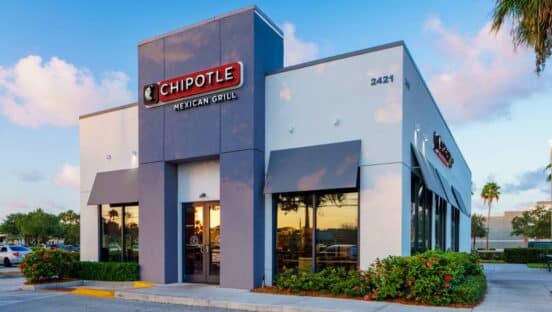














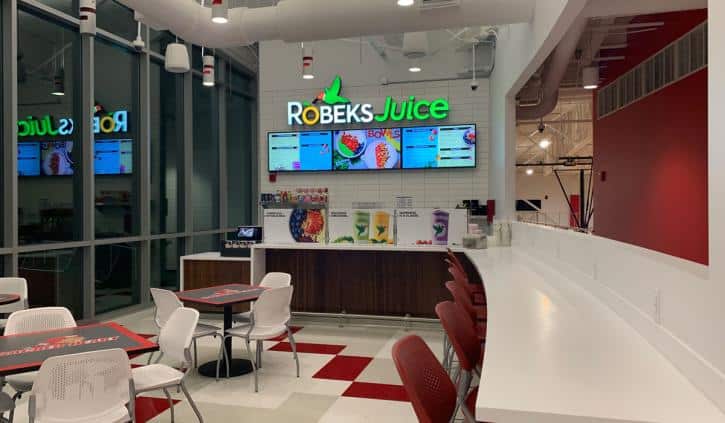





Dickey’s Barbecue Pit
80 Years
When Travis Dickey opened Dickey’s Barbecue Pit in
Dallas in 1941, it’s unlikely he ever envisioned a global franchising empire. He ran it for 25 years, originally converting what was an old beer bar into a mainstay. Next in the brand’s leadership came Travis’s son, Roland (the first) and, eventually, grandson Roland Jr.
When Roland Jr. and his wife, now-CEO Laura Rea Dickey, came onboard, there were about 20 stores. Now there are more than 600 in 46 states and developing in 36 countries. Dickey’s is one of the few barbecue joints—a notoriously fickle and regional segment—to have apreciated success at scale. Laura and Roland attribute that to preserving the best parts of Dickey’s heritage and operating with an “evolve-or-fail” mentality.
People want Texas barbecue all over the world, the Dickeys say. And new units in locations like Pakistan, Tokyo, and Singapore prove it. In less than five years, the Dickeys believe international growth will overtake domestic.
No matter where Dickey’s goes, however, the core of the craft barbecue and family-driven brand, the authenticity of the 12–14 hour smoked hickory wood burning pit in each restaurant, is a timeless and endearing base to build from, Laura says.
“I love the American success story,” Laura says. “I love to be an example that, as a family business, that you can work hard and if you do both well and good in your community, that if you truly are a good neighbor, you’re a good part of your community, that folks recognize that.”
Even though Dickey’s is a legacy brand, the company leaned into technology and embraced the convenience of digital ordering, third-party delivery, and catering during the pandemic. Dickey’s main priorities are twofold: boosting owner-operator success and optimizing the guest experience for a couple more dollars than the traditional fast-food meal.
Part of that latter promise included a move to open kitchens so guests can view the hickory wood burning pit.
Roland compares the restaurant’s business transformation to his own in car choice—the equivalent of going from a red Chevy Cavalier with a green door to a Mercedes. Growth has been a byproduct of success, with more than half of the new stores opened under existing operator ownership.
Dickey’s philosophy did not change amid 2020’s challenges.
“Roland and I got on the phone together and said, OK, it was never a question of if we were going to succeed, it was how we were going to do that,” Laura says.
Immediately, Dickey’s cut royalties down by 50 percent. The company also took a voluntary pay cut, something Laura thinks went a long way to show employees Dickey’s would strive to keep as many jobs as possible in the initial pandemic days.
“I think there are folks that might make choices in the industry because it’s an investment or it’s a decimal point on a spreadsheet, and we absolutely are here to make profit, and to be very, very profitable,” Laura says. “But we want to do it in a way that is fulfilling and creative and true to who we are.”
Dickey’s was ideally suited for COVID conditions because it’s a minimal contact concept, being year-over-year positive since May of last year. But beyond that, the brand maintains an entrepreneurial culture.
“Even though we’re 80 years old, we act like a startup,” Roland says. “I think that we wouldn’t have success if we didn’t. The difference between an entrepreneurial culture and others is action, action, action, always be taking action.”
The immediate uncertainty around how restaurants would adapt challenged Dickey’s, but by leaning into innovation, the company realized it could deliver barbecue to anyone, anywhere. This mindset led to optimization of Dickey’s website, increasing the threshold for web traffic by more than 300 percent.
Around the Fourth of July, Dickey’s set the largest sales record at a 13.9 percent increase in comps. Mother’s Day and Father’s Day holidays also experienced historic marks. While many restaurants worried about the cannibalization of online ordering with reopenings, Dickey’s direct delivery, third-party delivery, and pickup alone supported what the chain used to bring in revenue across all channels.
Dickey’s celebrated its anniversary with commemorative, limited edition Big Yellow Cups, and special menu items like the King’s Hawaiian Pulled Pork Sandwich topped with Dr Pepper barbecue sauce.
“We’ve always been about taking care of the guests because the original store that we keep going back to, actually before it was a beer joint when my grandfather got it, it was a house, and you don’t have a customer in a house, you have a guest,” Roland says.
Dickey’s intends to double its size in less than five years and grow to 700 restaurants by the end of 2021. But along the path, never lose sight of its neighborhood feel.
“If we’ve really done our job right, they have no idea that we’re the largest barbecue chain in the country and the world, and so that’s what I hope you see,” Laura says.
Carl’s Jr.
80 Years
In 1941, Carl Karcher opened the first Carl’s Jr. From its historic beginnings to now, the brand pushed boundaries, whether that meant introducing a plant-based burger at all restaurants or even crafting the first CBD-infused offering, Rocky Mountain High: CheeseBurger Delight.
CKE Restaurants CEO Ned Lyerly says the company’s longevity ties back to a decades-old culture that prioritizes guest service and a “trailblazing mindset.”
“Our customers and the industry are always looking at Carl’s Jr. to see what’s next, and we will continue to keep Carl Karcher’s entrepreneurial spirit alive in everything we do with the brand,” Lyerly says.
At 80, the brand hardly looks its age. It recently launched a NFT (non-fungible token) with Charlotte McKinney, becoming one of the first restaurant chains to incorporate this technology into a marketing plan.
Carl’s Jr also entered the chicken sandwich wars with three hand-breaded options, and it did so via an OnlyFans channel.
“We are still dreaming at 80 as we focus on dynamic growth, digital transformation, franchisee success, and an unwavering commitment to feed happiness to the global communities we serve,” Lyerly says. “It is going to be a fun ride as we lead with innovation, best in class quality and reimagine what quick service restaurants can be.”
Milo’s Hamburgers
75 Years
In 1946, Milo Carlton founded the first Milo’s Hamburgers. Carlton started as a mess cook in the U.S. Army and spent the first summer at Milo’s perfecting the secret sauce that Milo’s Hamburgers is still known for.
The Alabama staple has grown to 21 locations while staying true to its roots and consistently offering what the brand calls a “little something extra.” Carlton gave customers an extra piece of meat on top of their saucy burgers from day one, and still does today.
On April 16, Milo’s celebrated its anniversary by offering customers its original burger for only 75 cents. The hamburger chain sold 50,000 burgers and used 790 gallons of its famous sauce.
Jack in the Box
70 Years
Jack in the Box knows the value of being first to the dance. The 70-year-old brand crashed the scene as the inaugural drive-thru-focused chain in 1951, created what the company claims was the original quick-service packaged salad (1982), launched the sector’s debut breakfast sandwich (1969), and pioneered the 24/7 late-night model run.
On the eve of its septuagenarian years, Jack in the Box hasn’t lost sight of its upbringing as a category rule-breaker, CEO Darin Harris says.
“What’s unique about the 70th anniversary and how we’ve transitioned to a franchise model is that we’re back at that place that really brought Jack in the Box to life, which is an innovation model,” Harris says.
Harris says Jack in the Box was always a “challenger brand.” It majored in creating unexpected moments, whether that was customers indulging in breakfast-for-dinner and dinner-for-breakfast or enabling a kitchen cook to rise and become a successful franchisee. Roughly 75 percent of current operators started working within the 2,200-plus Jack in the Box restaurants across America.
Over the past seven decades, Jack in the Box morphed from a company model to a franchise one, as Harris notes, and in the last 10 years, the strategy amplified as Jack in the Box focused on selling corporate units and shifting to a mindset of helping franchisees grow.
“That’s a big cultural shift because you go from really supporting your restaurants and operators to run them to a servant mindset, and how do we provide the tools for franchisees to be successful,” Harris says.
Naturally, Jack in the Box underwent significant menu changes and additions since it debuted as a hamburger shop in the 1950s. The brand helped tacos and breakfast surge into the quintessential American drive-thru experience.
More recently, Harris helped navigate choppy waters. For multiple years, franchisees were mired in a legal battle with Jack in the Box corporate, concerned over the direction the company was headed in regards to marketing and other points.
Harris, a former CiCi’s Pizza CEO and Arby’s SVP, says when he came on board in June 2020 he was excited to walk into an opportunity with irreplaceable history and brand equity, but he knew he would need to bring the two sides together.
“Some people would say that’s a deterrent, ‘I don’t want to come into a situation like that,’” Harris says. “For me, that’s exciting. I can’t wait to get a chance to connect with the franchisees and start with the relationship. And that’s what we did.”
Even before jumping in, Harris called about 30 franchisees and asked them to tell him about themselves, their families, and how they got started in the business. One began as a cook and now has more than 200 franchised businesses from different brands.
Surviving multiple owners, public and private, Jack in the Box has not been without its own challenges, roadblocks, and even tragedies over the years.
In 1993, an E. coli outbreak was traced to Jack in the Box restaurants, with bacteria from the hamburgers sickening hundreds in several states and leading to four deaths.
“The E. coli incident was a pivotal point in the brand’s history because they came together to make sure that in food safety and industry that they were the top of the food chain and the best in food safety,” Harris says. “For years Jack in the Box has been known for that since that event.”
With COVID-19, Jack in the Box worked to support franchisees by reducing rent and royalties in addition to help in obtaining loans if they needed it.
But even throughout the stretch, the floor didn’t drop from under them, Harris says. In fact, within a few months, Jack in the Box stores were performing quite well, thanks in large part to the drive-thru. Overnight, business became 95–98 percent off-premises (drive thru or delivery).
By innovating the Jack in the Box menu with family deals and leaning into third-party delivery, business took off.
“During that time, what we were the beneficiary of is learning more about our guests and doing research about our guests about what they wanted more from Jack and how we could digitally reach them on one to one to one level,” Harris says.
By 2025, Jack in the Box hopes to reach 4 percent annual restaurant growth rate in units, filling existing markets with current franchisees and moving east. The goal: 6,000 locations.
But when it comes to what Harris believes sustained Jack in the Box for 70 years, it boils down to understanding guests and what they want from the brand, providing great, craveable food, and a constant nod to thinking ahead.
Togo’s
50 Years
When Mike Cobler founded Togo’s in 1971, he had a singular focus in mind: create a place that made sandwiches the way he liked them, big, fresh, and meaty. The first Togo’s was a small sandwich shack that captured the attention of students in San Jose, California. The second opened downtown in San Jose in 1974, and by 1977, the brand started franchising.
Ownership varied over the years with Togo’s once being in a three-concept partnership with Dunkin’ and Baskin-Robbins under Allied Domecq Restaurants. Even amid changes, Togo’s endured and now has 172 stores across the West Coast with seven locations poised to open in the second half of 2021.
“Togo’s has continuously adapted to customer trends without sacrificing the brand’s principles of quality, taste, and big portions,” Togo’s CEO Glenn Lunde says.
In an effort to make the Togo’s experience easier for employees and guests, the brand launched Togo’s 3.0 system, an investment in technology to ensure online ordering, loyalty, POS, and third-party delivery are integrated for speed and simplicity. A new “speed line” became a mainstay in the sandwich building kitchen design. Lunde says having these in place before the pandemic allowed Togo’s to handle the overnight jump in off-premises orders of 15 percent of sales to 35 percent.
Sales dropped 45 percent initially out of the COVID gates. But by the end of the year, Togo’s was only down 4 percent. Overall, sales plummeted 12 percent during 2020 before rebounding 20 percent year-to-date in 2021.
“I would say prioritizing high quality, great flavor, and huge portions served with fast and engaging service have been the cornerstones of Togo’s since it was founded 50 years ago,” Lunde says. “It’s also important to have passionate operators who have a relentless focus on our founder’s mission of, ‘striving to make the best better.’”
For the years ahead, Lunde says Togo’s will continue to remodel existing stores with the speedline operations and 3.0 design. This alongside prioritized growth in California and neighboring states as Togo’s opens its first stores in Nevada, two in the Las Vegas area, and one in Reno.
Pollo Campero
50 Years
Pollo Campero, founded in Guatemala, began as a small family-owned restaurant and has since transformed into a 350-unit chicken concept 50 years later. Guests still flock to the brand for its seasoned fried chicken and citrus-marinated grilled chicken entrees, says Luis Javiar Rodas, managing director and COO Pollo Campero USA.
The pandemic led to unforeseen challenges in the restaurant industry, but these were challenges Pollo Campero was prepared to meet.
“2020 was a challenging year in which Pollo Campero demonstrated its resilience and relevance,” Javiar Rodas says. “We quickly pivoted to provide innovative solutions to serve guests in a safe and convenient manner while protecting the core of our value proposition.”
Staying true to its brand values meant supporting communities through the pandemic by providing meals and masks to teachers, frontline workers, and those in need.
“The 2020 results were a record performance for the brand in sales, profits, and guest satisfaction metrics, and we continue to sustain this momentum during our 50th anniversary year,” Javiar Rodas says.
While the brand celebrated its golden anniversary, it launched new menu items, including a chicken sandwich and Camperitos hand-breaded, white-meat nuggets, and fried and grilled chicken bowls.
Pollo Campero hopes to double its footprint and reach more communities with both company-owned and franchised restaurants, targeting Georgia, South Carolina, Tennessee, and Arizona as key growth markets.
Starbucks
50 Years
In one of the most obvious statements imaginable, Starbucks has come a long way since its original location opened 1971 in Seattle’s Pike Place Market. The brand debuted some 33,000 stores in the next five decades.
“Over the past 50 years, we have built a company that’s about more than coffee,” says Starbucks CEO Kevin Johnson. “It’s about the human experience, connection and community, and we need that now more than ever.”
As the coffee giant heads into the second part of a century, it’s still dialed into an ethos-first mindset. The company recently announced a goal to achieve carbon neutral green coffee and conserve water usage in green coffee processing by 50 percent by 2030.
In that same vein, Starbucks expects to open a Coffee Innovation Park in China, which will be one of the first sustainable roasting plants in Starbucks’ global network.
Starbucks’ cold beverages are driving the future, too, accounting for more than $1 billion in sales growth over the past three years.
TCBY
40 Years
TCBY (The Country’s Best Yogurt) prides itself on providing nutritional benefits in its froyo desserts. Consumers who elect to eat foods that are vegan, GMO-free, gluten-free and dairy-free have a variety of choices at the chain, which now has hundreds of locations across the U.S.
In 2011, TCBY, the only chain that serves both soft-serve and hand-scooped frozen yogurt with the majority of flavors low in fat, nonfat or sugar-free, introduced its Super FroYo category, designated as the most nutritious flavors.
The pandemic has not slowed TCBY down. The brand said in June it had opened 12 new locations over the past year and planned to unveil six new units in the months ahead.
TCBY opened a new drive-thru version of its froyo shop in St. Augustine, Florida, over the summer as well as a self-serve store in Bayonne, New Jersey. TCBY celebrated its 40th anniversary with summer deals like a color-changing bowl for $1 across all locations.
“This anniversary is a significant milestone for TCBY, and the success of the brand has only been possible because of our loyal fans, dedicated franchisees and team,” says Nelson Tejada, CEO of Famous Brands International. “We are grateful for continued customer support which has helped us expand to new locations in the past year, and we are looking forward to bringing the brand to new locations and connecting with new customers.”
Farmer Boys
40 Years
“I picked up at the right time.”
That’s how David Wetzel, president and COO of Farmer Boys restaurants, described his timing as he transitioned into company leadership in June 2020, right in the middle of the COVID-19 pandemic. Appointed senior vice president of operations in January, and expected to become president halfway through the year, Wetzel had only six months to learn everything he could about the brand he’d lead and the team soon to be working under him.
With nearly 100 units (roughly a third corporate, two-thirds franchised) under his watch, Wetzel says he used the solid foundation already in place along with several strategic pivots to grow the company during a year when most restaurants were simply hoping not to shutter.
Even amid COVID, which saw many other quick-service restaurants face supply shortages, California-based Farmer Boys stayed true to its mission of providing fresh, locally sourced, made-to-order food for its customers, he says.
“We’re pretty fortunate in that we’re pretty tightly condensed geographically, so we can source from typically single sources,” Wetzel says. “If you go into any of our restaurants today, we have a board up on the wall as you enter and it shows all of our local vendors. So, we use fresh vegetables, we use Giuliano’s Bakery. We have a really nice set of dependable vendors that we’ve been dealing with for years and years. And we post those to the community so anybody can kind of check them out and look them up and make sure that they’re good folks that we do business with.”
The company, celebrating its 40th anniversary in October, stayed true to its mission statement last year while simultaneously injecting new technology into the drive-thru systems. This allowed Farmer Boys to keep pace with rising demand for contactless transactions, and gave some units a facelift with a more contemporary look.
“One of the first things that the operations team worked on when I came in was investing time and training and technology into the drive-thru business,” Wetzel says. “We were really just trying to improve our convenience and speed. We were also in the middle of integrating third-party delivery. Both of those decisions really became linchpins of the transition … linchpins that carried us through COVID. When COVID hit, business shifted dramatically, we were probably, I would guess we were about 40 percent [total sales] pre-COVID at the drive-thru, and within a week we were at 75 percent. We were able to pivot very quickly once it did hit and really shift all of our attention and focus to drive-thru, to go and delivery sales.”
From 2019 to 2020, Farmer Boys saw an increase of $17 million in total system sales, which Wetzel attributes to innovative LTOs, a beefed-up “Very Important” Farmer loyalty program, and successful marketing campaigns.
The restaurant saw success when it launched a LTO Farmer Boys fried chicken sandwich in the fall of 2020. The sandwich, offered in a regular or spicy option, quickly became one of the top sellers. The sandwiches continue to be one of the lead draws for guests, but they weren’t hatched overnight, Wetzel says.
“We actually initially tested the sandwiches five years ago,” he says. “And yeah, and it took us a long time to get the recipe just right and you know, to operationalize them. But we finally did. And they paid off big time.”
Farmer Boys’ loyalty program boasts between 750,000 and a million users. Wetzel says the program allowed the company to stay in communication with customers while dining rooms remained closed. Being able to alert guests to new menu items, deals, and safety protocols made sure people were up to speed even with lobbies and dining rooms shuttered. Constantly communicating new offerings through the loyalty program paired with successful TV campaigns helped Farmer Boys continue to drive traffic.
“Once we recovered post-COVID, we got into high single digit comps,” Wetzel says. “Very strong sales. And we held that for probably the last, I’m going to say 38 weeks of the year. So, we ended up with a positive year.”
One of the main tenets of the Farmer Boys philosophy is to give back to the communities where it operates. The brand partners with children’s hospitals to help raise money. Although budgets across the industry became tighter during the pandemic, it didn’t stop the California burger chain from continuing its philanthropic work.
“The biggest fundraiser that we do each year is for Loma Linda University Children’s Hospital,” Wetzel says. “That’s been a cause very near and dear to the founder’s hearts. Since our inception, every year we do a fundraiser for them. This year we actually added a round up your change component so that all year we can continue to collect funds for them. So far, we’ve donated over $1 million dollars to that cause. Similarly, we’re partnering with a children’s hospital in Nevada, and we just opened our first location in Gilbert, Arizona a few months ago, so we are going to be embarking on a similar effort with them.”
Other philanthropic ventures include fundraisers for local high schools, supporting local food banks, organizing blood donation drives, and providing meals for first responders such a firefighters and hospital staff. Having navigated COVID successfully, Farmer Boys is looking forward. The chain has locations throughout California, Las Vegas, and recently opened a unit in Gilbert, Arizona, with no plans of slowing. “We are most certainly stronger than we’ve ever been,” Wetzel says. “We’ve set very clear goals for ourselves for the next five years, and that is we’re going to grow our average unit sales by 50 percent. We’re going to grow our store base by 50 percent and I feel very comfortable and bullish about that.”
Aside from initiatives like the successful LTOs and revamped loyalty program, Wetzel credits employees for helping the company through trying times.
“It’s amazing to me what people can do, what they’re capable of,” Wetzel says. “You really determine the character of people during tougher times. And I got to tell you, this team had incredible character through this entire event. It brought us all closer. It made us smarter and stronger. That is what made the difference for us this entire time. And frankly, I think that’s what’s making the difference in a performance as well.”
Cowboy Chicken
40 Years
Cowboy Chicken initially started with a single location opened by founder Phil Sanders in Dallas in 1981. Now, the company has 17 units spanning Texas, Oklahoma, Georgia, and Louisiana. In recognition of hitting 40 years, Cowboy Chicken will give 40 families free chicken for a year.
“From the day Phil opened the doors of the very first Cowboy Chicken, our success has come down to the loyal guests who keep coming back week after week, year after year,” says Cowboy Chicken president and CEO Sean Kennedy. “It’s important to all of us at Cowboy Chicken that this celebration is all about our guests, because we wouldn’t be here without them.”
Some of the opportunities for guests also include a Secret Star promotion that will give away more than 1,000 free chickens to guests who receive a star on the back of their sales receipts. Cowboy Chicken also served a half-chicken with ranchero beans and signature Twice-Baked Potaters for $4 on Thursdays in August.
Cowboy Chicken grew considerably since 1981. In 1982, the restaurant introduced its famous chicken enchiladas, and two years later, a second location at Bachman Lake and Northwest Highway in Dallas opened. The first franchise store came later in 2010 in Allen, Texas.
Johnny Rockets
35 Years
The vintage, 1950s diner-themed Johnny Rockets is not the same brand it was when it first opened on Melrose Avenue in Los Angeles 35 years ago.
When FAT Brands acquired it in September 2020, one of the first things the group did was look at menu innovation. Plant-based options topped the list.
With new items like the Impossible Burger, Craig’s Vegan Shakes, and dairy free Daiya cheese, Johnny Rockets is just getting started on the food accessibility trend. Next, it looks to further enhance its menu with Impossible Foods Chicken Nuggets and selections from fast-food company Hot Dog on a Stick, which FAT Brands just acquired.
Going into its 36th year, growth is a main focus, and that includes a major redesign.
“During COVID, our store formats such as malls and amusement parks took a hit, but as we emerge from the pandemic, we are coming out stronger and are planning to give our locations a facelift that includes updated interiors and new A.I. communication tools to ensure customer satisfaction,” FAT Brands CEO Andy Wiederhorn says.
Charleys Philly Steaks
35 Years
The spark for Charleys Philly Steaks happened in 1985 when Charley Shin tasted his first Philly cheesesteak while attending Ohio State University. He opened his first restaurant in 1986, Charley’s Steakery, a 450-square foot unit near the school’s campus.
The current brand began franchising in 1991 and has scaled to more than 600 locations in 46 states and 17 countries, notably at malls, airports, and shopping complexes.
“Thirty-five years have flown by so quickly,” Shin says. “Over those years, I’ve learned that guest preferences evolve and brands that were once successful can see a decline over time if they don’t keep current. Charleys has always been a brand that tries new things, and we have seen that accelerating lately as we prepare for the future.”
Shin says some things will never change, including making sure guests are happy and ensuring the success of franchisees.
“A key motto for me, and one I pass on to our franchisees is, ‘don’t chase money, it will run from you. Take care of customers and success will come to you,’” Shin says. “We’ve been so blessed to see such growth and success for our franchisees and the brand.”
Julie Vulcain started as a franchise owner in 2002 at the Coral Square Mall in Coral Springs, Florida. Today, she has five locations throughout Florida, one of which was the first Charleys concept to sell both cheesesteaks and wings.
“It was so exciting to be part of the groundwork for the new concept—I knew we’d find success in expanding our customer base with the chicken wing products,” Vulcain says. “I look forward to many more years and many more openings with Charleys.”
Charleys president Candra Alisiswanto says the brand, originally a mall-based concept, has pivoted to opening locations outside because of the mall category’s slowdown in growth.
“This required a new understanding of our guests and our approach to the market,” Alisiswanto says. “It took some time for us to get it right, but we think we have it figured out now.”
The past three years saw significant expansion for Charleys, as it will bring 90 new locations to market this year with plans for 200 more in 2022. The next big Charleys milestone will be 1,000 stores in operation by 2024, Shin says.
“For a brand that is 35 years old to be so nimble and ready to attack the challenges it faces is really remarkable,” says Brian Hipsher, chief marketing officer. “In the last year, I’ve seen Charleys sharpen the brand positioning and messaging, launch online ordering and an app, support franchisees during the difficulties of COVID, and move extremely quickly to seize opportunities for location and sales growth. The future is bright because of the investments Charleys is making in its people, its technologies, and its brand promises.”
Andy’s Frozen Custard
35 Years
Parents John and Carol Kuntz launched Andy’s Frozen Custard, named for their son, in 1986. Today, there are more than 95 locations.
The namesake of the chain, Andy and his wife, Dana, spent countless hours learning the family business, and their leadership helped expand the company into greater Missouri, Arizona, Arkansas, Colorado, Florida, Georgia, Illinois, Kansas, Louisiana, North Carolina, Oklahoma, South Carolina, Tennessee, and Texas.
The original founders built Andy’s Frozen Custard on the principle that “If you are in the service business, you have to hire people that have a strong desire to serve. Pay them above average, train them well, and demand nothing but the best.”
To kick off its 35th celebration in March, Andy’s provided guests 35 cent buy one get one concretes.
“We are proud of what we have accomplished over these three plus decades, but nothing makes us prouder than being the treat of choice for family outings and special occasions,” says Andy Kuntz, Andy’s Frozen Custard CEO and owner. “We love knowing that kids celebrate the last day of school with one of 300,000 minis we typically donate each year. Seeing our parking lots filled with families enjoying Andy’s as part of a good old-fashioned hometown tailgate brings us joy.”
Toppers
30 Years
Three decades after Toppers opened its doors, the pizza chain still has plenty of runway. The company attributes fast service, technology, menu innovation, and quality ingredients to fueling its 2021 sales growth of 31.6 percent.
Many restaurants closed their doors or struggled to stay afloat during the pandemic. But Toppers, and the pizza industry at large, thrived with food designed for takeout in the American consumer’s psyche. Toppers’ first-party delivery and curbside platforms were vital, helping Toppers reach a year-to-date revenue growth of 20.5 percent with same-store sales up 16.4 percent.
Toppers saw 50 percent more customers in 2020 alone. Currently, the pizza chain has more than 69 locations in over 12 states.
Wayback Burgers
30 Years
Even during 2020, systemwide sales at Wayback lifted 4.9 percent and four locations opened. In the beginning of 2021, sales skyrocketed 30 percent.
Before COVID, the brand, born in Newark, Delaware, in 1991, entered a remodeling initiative that opted for a more modern restaurant environment that still guarded the nostalgic vibe. All of the remodeled locations generated 39 percent or better sales numbers in the backend of 2020 over the previous year. The burger chain also defied pandemic odds by upping its delivery and drive-thru game.
The company said in March it planned to open 15 stores across 10 states in 2021, its anniversary year. Wayback president Pat Conlin also noted the chain expected to award 24 new franchises and 17 restaurants to reach $1 million in sales.
Robeks
25 Years
Twenty-five years ago, smoothies were not exactly the widely known health-conscious option they are today.
One spark in the craze came when David Robertson founded Robeks. Robertson was inspired by his own affinity for smoothies he made at home before his workouts. The first Los Angeles-based Robeks opened after Robertson’s belief he could bring his own recipes into the quick-service marketplace.
Now for 25 years, Robeks, which has 86 units in 13 states, has offered inherently healthy products with a “flavor first” mantra.
“We believe that enjoying a smoothie should be one of the happiest parts of your day,” Robeks CEO David Rawnsley says. “The impact that we want to have on the communities that we serve is to make the customers look forward to going in and getting a smoothie every other day or a couple of days a week and start their day with some nutrition, and more importantly, with a good feeling about the rest of the day.”
Rawnsley first began working with Robeks after leaving corporate finance to pursue area development and franchising. While helping others determine if Robeks was the right investment, Rawnsley began to see how simple the brand was to operate and became a franchisee himself, three times over.
“It’s a series of innovation and evolution over time, always sort of keeping our gaze forward and trying to keep an eye out for products that have a good market awareness but are not oversaturated,” Rawnsley says.
Robeks was one of the first national brands to start putting greens into smoothies when it introduced the Tropi-Kale, a smoothie with kale, pineapple, pineapple sherbet, frozen yogurt, and papaya juice. More recently, Robeks also launched a line of avocado toasts.
Rawnsley says Robeks jumped on delivery opportunities during the pandemic and sales skyrocketed. Part of the heightened interest in the brand came in light of the pandemic itself, which sparked healthful and mindful awareness in many consumers.
Consistency is an integral element for the brand surviving to year 25, Robeks VP of marketing Mitch Baker says.
At the beginning of 2021, Robeks aimed to open 15 stores and is set to hit that mark. While the pandemic slowed down a large number of restaurants, Robeks strongly relied on its communication. On a regular basis, Robeks held town hall type meetings where franchisees could air concerns.
“We were really able to weather the storm and are emerging even stronger than when we went in,” Rawnsley says. “I think that really what positioned us to do that was an identification early on that our franchisees were the most important stakeholder within the Robeks system, and that the stronger that the franchisees come out of COVID, the stronger that the brand would be as a result.”
Robeks leadership team went to different marketplaces region-by-region to anticipate what franchisees needed. Immediately, they recognized banners would be helpful in showing customers they were open at a time when many weren’t.
“Other brands were communicating, but I think what separated us and positioned us to come out of this stronger was anticipating the needs of what the pandemic was going to require,” Rawnsley says.
Health-centric brands saw a boost generally during pandemic times, and Robeks benefited even more since its food was portable, Rawnsley says. But Robeks was intentional in not using pandemic scare tactics to encourage healthy drinking and eating.
“We didn’t play or pander to the pandemic or any kind of scare tactics where ‘you’ve got to get healthy, you’ve got to drink green juice right now and avoid COVID,’” Baker says. “But what we did is, we featured products that were already part of our menu that were inherently healthy.”
In 2021, sales rose 34 percent over pre-COVID 2019 numbers.
Robeks plans to grow to 100 storefronts by the end of the year and expand by 20 to 30 units each calendar after for the next couple of years.
“If you’ve been in business for, say, five years, you’ve got the winning ingredients to be successful,” Rawnsley says. “You need to stay true to who you are and just evolve and innovate to meet consumer preferences and demands but never really deviate from your core.”
Raising Cane’s
25 Years
Since 1996, Todd Graves’ Raising Cane’s has grown to nearly 600 restaurants, served 2.5 billion Box Combos, and provided $100 million in community support.
To honor the milestone, the chicken chain announced in August it plans to support nonprofits, organizations, schools and more with a commitment of $25 million for communities coast-to-coast over the next 12 months.
The brand has always stuck to its “6 Areas of Focus:” Education, Feeding the Hungry, Pet Welfare, Active Lifestyles, Business Development and Entrepreneurship, and Everything Else. In one example, Raising Cane’s annual holiday fundraiser has sold more than 300,000 Plush Puppies—modeled after Cane’s’ faithful canine mascot—generating nearly $1 million in donations to local pet welfare organizations.
Torchy’s Tacos
15 Years
It all began with a red Vespa, a food trailer, and a dream, Torchy’s Tacos Founder Mike Rypka says of the brand’s founding 15 years ago in Austin, Texas. Now, Torchy’s is nearing 100 locations.
“Torchy’s was built on unique tacos made from scratch and a commitment to being ‘Damn Good,’ from our ingredients and creativity, to how we treat our guests, team members and the communities we serve,” Torchy’s CEO GJ Hart says. “As we approach 100 locations across the country, we’re as proud and committed to be Damn Good as ever and look forward to celebrating with our loyal Taco Junkies.”
Founder Mike Rypka admits it’s “crazy” to think back to where Torchy’s started and where it is today.
“Despite our humble beginnings in a food trailer, back when food trucks weren’t yet cool, I knew Torchy’s was bigger than it was on opening day, and it still feels bigger than all of us today,” Rypka says.
Yogurtland
15 Years
In 2006, Phillip Chang opened Yogurtland’s doors in Fullerton, California, under the vision of providing a self-serve frozen yogurt experience that went above and beyond in quality ingredients and flavors. Yogurtland has more than 250 locations across the U.S., Dubai, Guam, Myanmar, Oman, Indonesia, and Thailand.
In its 15th year, Yogurtland launched a first with Fruit Bowl Fusions and Acai Bowls in an effort to build upon the interest in refreshing, healthy summer eating.
WaBa Grill
15 Years
The health kick spurted by the coronavirus led to WaBa Grill reaching record growth as the chain entered its 15th year. The 2020 fiscal calebdar ended with records of total system sales, up 3 percent, with over 25 percent of all business coming from digital sales channels compared to 4.5 percent in 2019.
WaBa Grill released a refreshed mobile rewards app with a new look and increased member benefits.
“Consumer demand for convenient, affordable and healthy options will continue to grow, and it’s a sweet spot that we’ve been perfecting for 15 years,” said Mark Finnegan, chief marketing and information officer at WaBa Grill, early in the year. “Despite the many uncertainties brought on by 2020, our sales are evidence that there has never been a better time to invest with WaBa Grill.”
BurgerFi
10 Years
“BurgerFi’s foundation, concept, and core values are a few of the many factors that continue to keep the brand thriving for the last 10 years,” said Ophir Sternberg, executive chairman of BurgerFi, in January. “While the journey started a decade ago in Lauderdale-By-the-Sea, BurgerFi’s distinguishing attributes remain important to its growth, as the brand continues to deliver exceptional value for all guests, team members, investors and the communities they serve.”
BurgerFi celebrated its 10th birthday with a menu that oozed the birthday theme, including a birthday cake shake made up of confetti cake and vanilla custard and a mini cupcake along with BurgerFi’s concrete with layers of birthday cake.
Now operating more than 120 restaurants, the publicly traded brand continues to grow in locations across the U.S. and internationally. The menu transformed over the past decade as well, going from initially just burgers to chicken, hot dogs, fries, onion rings, and custard desserts.





